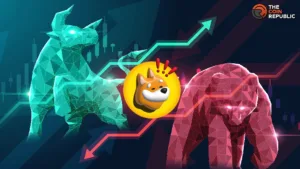To get the show every day, follow the podcast here.
On “Markets Daily,” host Jennifer Sanasie speaks with Andy Baehr, managing director of CoinDesk Indices, about the “season finale” of crypto winter and the recent launch of the CoinDesk 20 Index.
This episode was hosted by Jennifer Sanasie. “Markets Daily” is executive produced by Jared Schwartz and produced and edited by Eleanor Pahl, alongside Senior Booking Producer Melissa Montañez. All original music by Doc Blust and Colin Mealey.
Audio Transcript: This transcript has not been edited and may contain errors.
JENNIFER SANASIE:
It’s Thursday, January 18th, 2024 and this is “Markets Daily” from CoinDesk. I’m your host Jenn Sanasie and let’s dive into those prices. According to CoinDesk Indices, at 8 a.m. Eastern time, bitcoin was trading down 0.83% over the past 24 hours at $42,376. And, in an ETF update, BlackRock’s Bitcoin ETF has become the first spot bitcoin ETF in the U.S. to reach the milestone of $1B in assets under management. Ether fell 1.5% over the same time period, trading at $2,509. Today’s ‘Mover’ in the CoinDesk Market Index is LCX, up 12% on the day. In traditional markets, both the NASDAQ and the S&P 500 fell around half a percent yesterday. Lastly, in commodities, the Brent crude benchmark was trading at 77 dollars and 95 cents a barrel. Meanwhile, gold prices have been retreating, hitting a one-month low yesterday. However, early trading this morning shows a slight uptrend in safe-haven demand. As of 8 a.m. Eastern time, Gold was trading at $2015 dollars an ounce. For more on the markets action, let’s bring in Andy Baehr, Managing Director at CoinDesk Indices. Let’s talk about that ETF news I just mentioned. BlackRock has a billion dollars assets under management. It is exactly one week to the day that we got our first ETF in the United States. Talk to us about what you’ve been watching over the last week.
ANDY BAEHR:
It was a great experience. Last week, we kind of all gathered around our screens and watched what we thought of as the season finale of crypto winter. Right, and as a season finale, it delivered. It had the intrigue, the 11th hour intrigue, of the hacked SEX x.com account. It had the dueling statements by Chair Gensler and by Commissioner Pierce. The trading was excited but orderly on the day of the launches, considering how many new products were coming to market and how many incumbent products were coming. And how that a lot of the ETF participants, the APs and other market makers and bases traders and futures traders kind of had to do a big production number. It was a very orderly and successful first day. And then you know, since then we kind of have to zoom out a little bit. Now that the news is behind us, we didn’t get the bitcoin crash that some had predicted directly after the launch of the ETFs. We found support at the $42,000 level. The bitcoin trend indicator pulled back one level from significant uptrend to uptrend, so allocators using that strategy have moved a little bit of their allocation into cash, but really smooth sailing. And now we look for more and more people to start adopting bitcoin via the ETFs.
JENNIFER SANASIE:
You mentioned the price of bitcoin there, we did see it rally, and then retreat, as you mentioned, and on this show, we use the CoinDesk Market Index to pull one mover with big price moves every single day. And there are a lot of movers out there, as our listeners know outside of bitcoin outside of Ethereum. Let’s talk about the movers that you’ve been watching, and I want to start with a top performer in recent days.
ANDY BAEHR:
Well, what has been interesting to watch and has been the case in previous cycles is that bitcoin will kind of lead a rally out, especially out of a dark place, right because it has more liquidity. It has more market structure. And think about the beginning of 2023 when things felt pretty dire. Bitcoin led the charge back ahead of a lot of the alts and head of Ethereum. In fact, now that bitcoin has kind of regained its health, it has these new avenues for availability to a wider group of investors, I think you’ll see a lot of the alts start to come back based on their fundamentals and based on regained optimism, individual tokens, I think will be volatile on their own clocks, probably due to, you know, very small pockets of people kind of trading them over time. What we hope this means that there’s more diversification in the market, right? And that owning an index with that’s carefully selected of coins will actually give you a better risk adjusted performance than holding any one token in particular.
JENNIFER SANASIE:
Has there been a particular sector that has outperformed the others, either up or down? That has been surprising to you?
ANDY BAEHR:
I think, you know, the focus has been so much on the majors and the market structure around the majors, that a lot of the noise underneath. It sort of moves from day to day, but doesn’t really give us a clear trend. I think, you know, this is the season when we’re inviting a lot of new people into the room. There are many more institutions who are educating on a more traditional finance kind of way, how digital assets work, and getting them started. So I think there are days when we see the smart contract platform sector do well, the computing sector do well, the DeFi sector do well, over time, we like actually the fact most that the sector’s kind of trade places amongst best and worst performers because that means the CMI, the CoinDesk Market Index, and our new index, the CoinDesk 20 Index will kind of benefit from that diversification and give investors better risk adjusted returns.
JENNIFER SANASIE:
I’m glad you brought up the CoinDesk 20 Index that launched this week. And as the industry matures, you know, we have the approval of the spot bitcoin ETF. We have TradFi players now coming into crypto. The CoinDesk 20 Index, I think is you know, signifies something, it’s an S&P 500 like gauge for crypto traders. Tell us more about what this means for a growing industry like this one.
ANDY BAEHR:
For sure. You know, we launched the CoinDesk Market Index last year. And because the market really needed a way, as you pointed out, and to help, you know, support your questions, let’s look at sectors, let’s look as broad as we can and see what information we can get as we regard the market right now. Now that bitcoin is sort of becoming something that’s going to be very, very broadly available not only in the United States, but in other countries that are beginning to allow new wrappers, people are going to be more interested in going beyond bitcoin, and going beyond ether and seeing what else is out there. They’ll understand blockchain, they’ll understand the different investment cases. And like many other asset classes, they’re going to look for diversification, right? They’re going to look for that kind of free lunch that investing gives you that you can get better risk adjusted returns with a diversified index. So we launched the CoinDesk 20. With three objectives in mind, we want it to be the best reference for the new digital asset class for everybody to use. We want it to be a great benchmark for investment products. And thirdly, and most uniquely, we want it to be the index that’s easy for users to trade. Those are when we think about things like equity indices. Sometimes we take those three things for granted. But they really are three different pieces of market structure. And maybe we can talk about, you know, kind of each of those.
JENNIFER SANASIE:
Well, let’s get into it. Talk to us about what traders and investors who are looking to allocate their portfolio this morning should take away from each of those.
ANDY BAEHR:
So let’s think about investing first, that’s the easiest case. And maybe listeners might be most familiar with a mutual fund. And if you look in your 401k, you probably have a lot of mutual funds. There, a manager is trying to actually look at an index, buy the underlying constituents, hold on to them, and present you a vehicle that you’re meant to sort of hold for time, right? You don’t want to trade into or out of it. You trade in at nav you trade out at NAV. And it’s meant to be a long term holding vehicle and you’re going to benchmark the returns of that vehicle to an index. So critically important. Let’s think about trading though. institutions, banks, insurance companies, hedge funds. Let’s take an example from 25 years ago, they started trading the QQQ as a way to trade the future of tech, it became an ETF, this kind of monstrously liquid thing because liquidity was created by institutions, and used by other institutions and eventually used by retail. So sure, you can hold on to a QQQ ETF for 10 years, but you can also trade into or out of it many times a day. And so as a piece of market structure, that index supported a much higher frequency of transactions. The third piece referencing, you know, if you listen to traditional finance, the sort of Wall Street report, you’ll hear about the NASDAQ Composite Index, you’ll hear about the S&P 500. You’ll hear of course, about the Dow Jones Industrial Average, really only one of those threes in investable tradable index, the NASDAQ Composite has 1000s of stocks and not many products are benchmarked against the Dow. So for CoinDesk 20. We wanted to try to achieve all three things. Most interestingly, Bullish exchange launched perpetual futures on the CoinDesk 20. So now as of a couple of days ago, millions of dollars worth of CoinDesk 20 units are being traded amongst crypto native market professionals.
JENNIFER SANASIE:
All right, and before we get into our last question, I should make a disclosure. Bullish is the owner of CoinDesk. Okay, Andy, just before we wrap up our chat here, I have to ask you. Last week on “Markets Daily,” Kevin O’Leary joined us and he said that he would hazard to say that digital and crypto will end up being the 12th sector of the S&P 500. What do you make of his comments?
ANDY BAEHR:
I think it’s I have bigger aspirations than he does, which is which is probably seeing something because he is someone known to not shy away from having big aspirations. The digital asset classes born right now it will be its own independent asset class. Aside from equities and commodities, rates, currencies, credit, it will stand alone as the future of finance but also an asset class where the constituents of indices are the constituents of asset class of the asset class will have more to do with each other than with other things. Its global, its blockchain, its decentralized. It’s a great thing to think of as a unit. So CoinDesk 20 will be the reference of that asset class. Bitcoin will certainly be for some time the biggest constituent, but I think it’ll stand alongside equities and be something that portfolio managers will allocate to on the asset class basis, not as a sector of another asset class.
JENNIFER SANASIE:
Andy, thanks so much for joining “Markets Daily.” Thank you so much. That was CoinDesk Indices Managing Director Andy Baehr. And that’s it for today’s show.
Read the full article here









